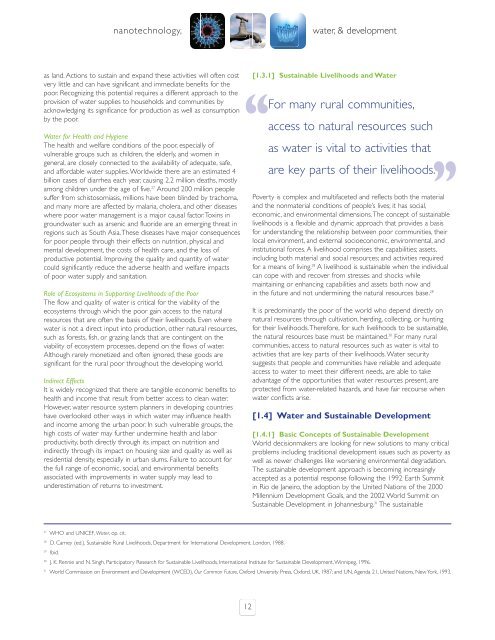Global Dialogue on Nanotechnology and the Poor ... - Nanowerk
Global Dialogue on Nanotechnology and the Poor ... - Nanowerk
Global Dialogue on Nanotechnology and the Poor ... - Nanowerk
Create successful ePaper yourself
Turn your PDF publications into a flip-book with our unique Google optimized e-Paper software.
nanotechnology,<br />
water, & development<br />
as l<strong>and</strong>. Acti<strong>on</strong>s to sustain <strong>and</strong> exp<strong>and</strong> <strong>the</strong>se activities will often cost<br />
very little <strong>and</strong> can have significant <strong>and</strong> immediate benefits for <strong>the</strong><br />
poor. Recognizing this potential requires a different approach to <strong>the</strong><br />
provisi<strong>on</strong> of water supplies to households <strong>and</strong> communities by<br />
acknowledging its significance for producti<strong>on</strong> as well as c<strong>on</strong>sumpti<strong>on</strong><br />
by <strong>the</strong> poor.<br />
Water for Health <strong>and</strong> Hygiene<br />
The health <strong>and</strong> welfare c<strong>on</strong>diti<strong>on</strong>s of <strong>the</strong> poor, especially of<br />
vulnerable groups such as children, <strong>the</strong> elderly, <strong>and</strong> women in<br />
general, are closely c<strong>on</strong>nected to <strong>the</strong> availability of adequate, safe,<br />
<strong>and</strong> affordable water supplies.Worldwide <strong>the</strong>re are an estimated 4<br />
billi<strong>on</strong> cases of diarrhea each year, causing 2.2 milli<strong>on</strong> deaths, mostly<br />
am<strong>on</strong>g children under <strong>the</strong> age of five. 27 Around 200 milli<strong>on</strong> people<br />
suffer from schistosomiasis, milli<strong>on</strong>s have been blinded by trachoma,<br />
<strong>and</strong> many more are affected by malaria, cholera, <strong>and</strong> o<strong>the</strong>r diseases<br />
where poor water management is a major causal factor.Toxins in<br />
groundwater such as arsenic <strong>and</strong> fluoride are an emerging threat in<br />
regi<strong>on</strong>s such as South Asia.These diseases have major c<strong>on</strong>sequences<br />
for poor people through <strong>the</strong>ir effects <strong>on</strong> nutriti<strong>on</strong>, physical <strong>and</strong><br />
mental development, <strong>the</strong> costs of health care, <strong>and</strong> <strong>the</strong> loss of<br />
productive potential. Improving <strong>the</strong> quality <strong>and</strong> quantity of water<br />
could significantly reduce <strong>the</strong> adverse health <strong>and</strong> welfare impacts<br />
of poor water supply <strong>and</strong> sanitati<strong>on</strong>.<br />
Role of Ecosystems in Supporting Livelihoods of <strong>the</strong> <strong>Poor</strong><br />
The flow <strong>and</strong> quality of water is critical for <strong>the</strong> viability of <strong>the</strong><br />
ecosystems through which <strong>the</strong> poor gain access to <strong>the</strong> natural<br />
resources that are often <strong>the</strong> basis of <strong>the</strong>ir livelihoods. Even where<br />
water is not a direct input into producti<strong>on</strong>, o<strong>the</strong>r natural resources,<br />
such as forests, fish, or grazing l<strong>and</strong>s that are c<strong>on</strong>tingent <strong>on</strong> <strong>the</strong><br />
viability of ecosystem processes, depend <strong>on</strong> <strong>the</strong> flows of water.<br />
Although rarely m<strong>on</strong>etized <strong>and</strong> often ignored, <strong>the</strong>se goods are<br />
significant for <strong>the</strong> rural poor throughout <strong>the</strong> developing world.<br />
Indirect Effects<br />
It is widely recognized that <strong>the</strong>re are tangible ec<strong>on</strong>omic benefits to<br />
health <strong>and</strong> income that result from better access to clean water.<br />
However, water resource system planners in developing countries<br />
have overlooked o<strong>the</strong>r ways in which water may influence health<br />
<strong>and</strong> income am<strong>on</strong>g <strong>the</strong> urban poor. In such vulnerable groups, <strong>the</strong><br />
high costs of water may fur<strong>the</strong>r undermine health <strong>and</strong> labor<br />
productivity, both directly through its impact <strong>on</strong> nutriti<strong>on</strong> <strong>and</strong><br />
indirectly through its impact <strong>on</strong> housing size <strong>and</strong> quality as well as<br />
residential density, especially in urban slums. Failure to account for<br />
<strong>the</strong> full range of ec<strong>on</strong>omic, social, <strong>and</strong> envir<strong>on</strong>mental benefits<br />
associated with improvements in water supply may lead to<br />
underestimati<strong>on</strong> of returns to investment.<br />
[1.3.1] Sustainable Livelihoods <strong>and</strong> Water<br />
‘‘<br />
For many rural communities,<br />
access to natural resources such<br />
as water is vital to activities that<br />
’’<br />
are key parts of <strong>the</strong>ir livelihoods.<br />
Poverty is complex <strong>and</strong> multifaceted <strong>and</strong> reflects both <strong>the</strong> material<br />
<strong>and</strong> <strong>the</strong> n<strong>on</strong>material c<strong>on</strong>diti<strong>on</strong>s of people’s lives; it has social,<br />
ec<strong>on</strong>omic, <strong>and</strong> envir<strong>on</strong>mental dimensi<strong>on</strong>s.The c<strong>on</strong>cept of sustainable<br />
livelihoods is a flexible <strong>and</strong> dynamic approach that provides a basis<br />
for underst<strong>and</strong>ing <strong>the</strong> relati<strong>on</strong>ship between poor communities, <strong>the</strong>ir<br />
local envir<strong>on</strong>ment, <strong>and</strong> external socioec<strong>on</strong>omic, envir<strong>on</strong>mental, <strong>and</strong><br />
instituti<strong>on</strong>al forces. A livelihood comprises <strong>the</strong> capabilities; assets,<br />
including both material <strong>and</strong> social resources; <strong>and</strong> activities required<br />
for a means of living. 28 A livelihood is sustainable when <strong>the</strong> individual<br />
can cope with <strong>and</strong> recover from stresses <strong>and</strong> shocks while<br />
maintaining or enhancing capabilities <strong>and</strong> assets both now <strong>and</strong><br />
in <strong>the</strong> future <strong>and</strong> not undermining <strong>the</strong> natural resources base. 28<br />
It is predominantly <strong>the</strong> poor of <strong>the</strong> world who depend directly <strong>on</strong><br />
natural resources through cultivati<strong>on</strong>, herding, collecting, or hunting<br />
for <strong>the</strong>ir livelihoods.Therefore, for such livelihoods to be sustainable,<br />
<strong>the</strong> natural resources base must be maintained. 30 For many rural<br />
communities, access to natural resources such as water is vital to<br />
activities that are key parts of <strong>the</strong>ir livelihoods. Water security<br />
suggests that people <strong>and</strong> communities have reliable <strong>and</strong> adequate<br />
access to water to meet <strong>the</strong>ir different needs, are able to take<br />
advantage of <strong>the</strong> opportunities that water resources present, are<br />
protected from water-related hazards, <strong>and</strong> have fair recourse when<br />
water c<strong>on</strong>flicts arise.<br />
[1.4] Water <strong>and</strong> Sustainable Development<br />
[1.4.1] Basic C<strong>on</strong>cepts of Sustainable Development<br />
World decisi<strong>on</strong>makers are looking for new soluti<strong>on</strong>s to many critical<br />
problems including traditi<strong>on</strong>al development issues such as poverty as<br />
well as newer challenges like worsening envir<strong>on</strong>mental degradati<strong>on</strong>.<br />
The sustainable development approach is becoming increasingly<br />
accepted as a potential resp<strong>on</strong>se following <strong>the</strong> 1992 Earth Summit<br />
in Rio de Janeiro, <strong>the</strong> adopti<strong>on</strong> by <strong>the</strong> United Nati<strong>on</strong>s of <strong>the</strong> 2000<br />
Millennium Development Goals, <strong>and</strong> <strong>the</strong> 2002 World Summit <strong>on</strong><br />
Sustainable Development in Johannesburg. 31 The sustainable<br />
27<br />
WHO <strong>and</strong> UNICEF, Water, op. cit.<br />
28<br />
D. Carney (ed.), Sustainable Rural Livelihoods, Department for Internati<strong>on</strong>al Development, L<strong>on</strong>d<strong>on</strong>, 1988.<br />
29<br />
Ibid.<br />
30<br />
J. K. Rennie <strong>and</strong> N. Singh, Participatory Research for Sustainable Livelihoods, Internati<strong>on</strong>al Institute for Sustainable Development,Winnipeg, 1996.<br />
31<br />
World Commissi<strong>on</strong> <strong>on</strong> Envir<strong>on</strong>ment <strong>and</strong> Development (WCED), Our Comm<strong>on</strong> Future, Oxford University Press, Oxford, UK, 1987; <strong>and</strong> UN, Agenda 21, United Nati<strong>on</strong>s, New York, 1993.<br />
12
















